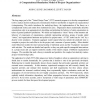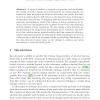861 search results - page 86 / 173 » Predicting Attack-prone Components |
BMCBI
2007
2007
Application of amino acid occurrence for discriminating different folding types of globular proteins
13 years 11 months ago
Background: Predicting the three-dimensional structure of a protein from its amino acid sequence is a long-standing goal in computational/molecular biology. The discrimination of ...
CACM
1998
13 years 10 months ago
1998
The long range goal of the “Virtual Design Team” (VDT) research program is to develop computational tools to analyze decision making and communication behavior and thereby to ...
JOCN
2010
13 years 9 months ago
2010
■ The neural activity of speech sound processing (the N1 component of the auditory ERP) can be suppressed if a speech sound is accompanied by concordant lip movements. Here we d...
CVPR
2006
IEEE
15 years 23 days ago
2006
IEEE
Simultaneous localisation and mapping using a single camera becomes difficult when erratic motions violate predictive motion models. This problem needs to be addressed when visual...
ESORICS
2009
Springer
14 years 11 months ago
2009
Springer
Abstract. A range of attacks on network components, such as algorithmic denial-of-service attacks and cryptanalysis via timing attacks, are enabled by data structures for which an ...




